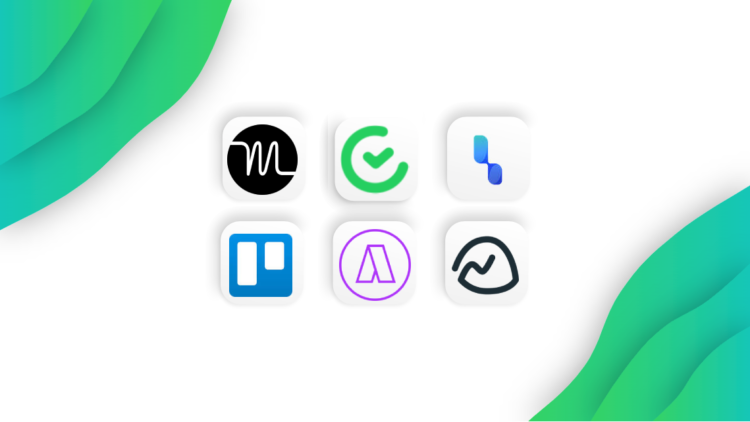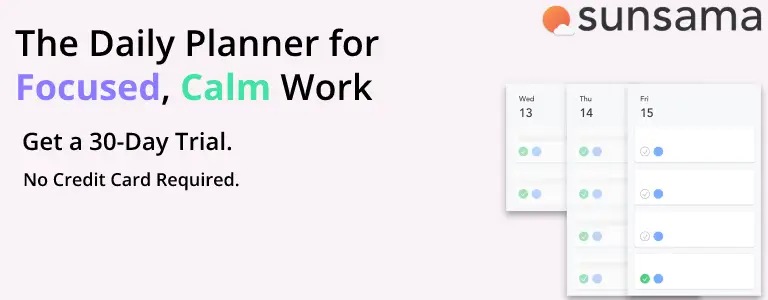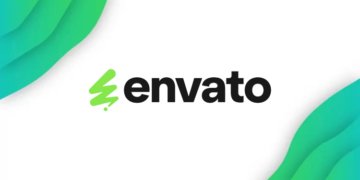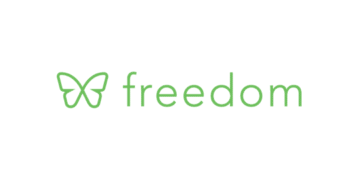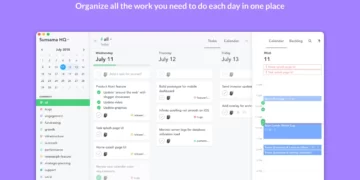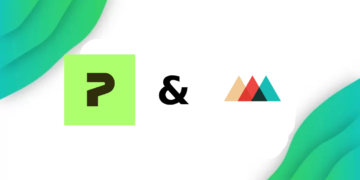Caffeine is Reader Supported, If you do buy through links on our website, we may earn a commission at no extra cost to you. Read the full disclaimer here
Planning your tasks ahead of time is a vital part of any productive person’s day, and it can be the reason that makes or breaks your entire day or week, so you need to always plan your tasks ahead, but how do you do that?
Well, the simplest way is using an app that streamlines most of that process, which is what most people use. if you are in the productivity app space, then you’ve probably repeatedly heard of Sunsama, and for good reason, since it is one of the best productivity apps.
If you are unfamiliar with Sunsama, It is one of the best task management and timeboxing apps available, you can use it to pull tasks from other apps, add them to your calendar, and organize them so you can get to them all. using Sunsama will almost certainly help you be more productive.
However, as we all know, there is no single productivity app that suits everyone, so it’s always good to have alternatives available in case a specific productivity app doesn’t suit you.
1. Motion
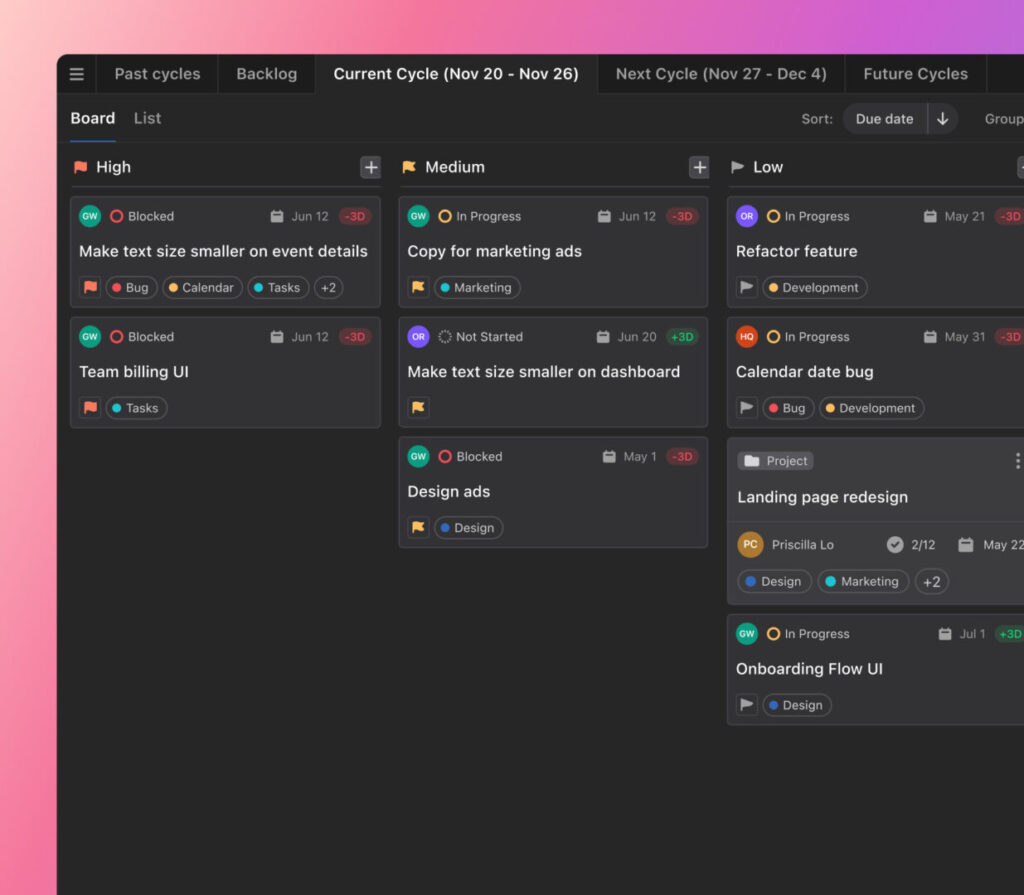
The first app on our list is Motion, Motion is a task management app very similar to Sunsama, since it has some very similar timeboxing features, but Motion has one big feature that Sunsama doesn’t have, which is AI capabilities.
Motion uses AI to essentially manage your time for you. Motion will automatically schedule tasks based on your workload, free time, booked meetings, and deadlines.
When adding tasks to Motion, you are able to specify the importance of the task, how long it will take, when you can do it, if you are able to split it into multiple chunks, and the deadline of the task.
you can also automatically book meetings by using a keyboard shortcut to automatically send your available times, as well as a booking link in an email so you can easily book meetings without the hassle of checking your calendar and making sure the time also works for however you’re meeting.
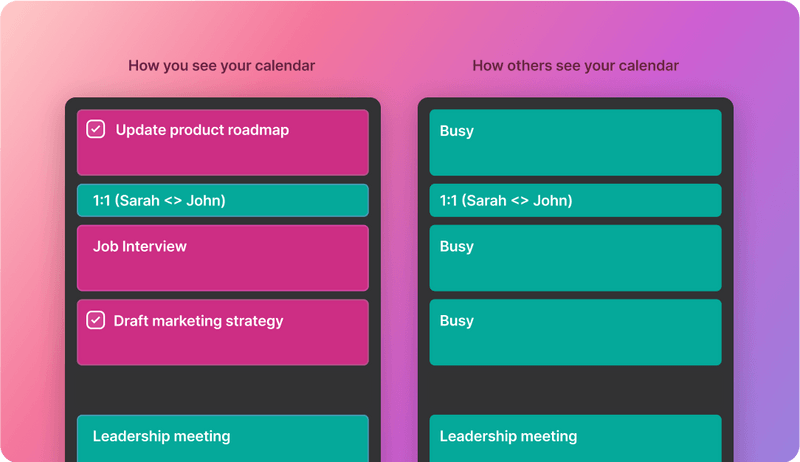
Motion will also assign tasks around your schedule if you had some tasks already booked within google calendar. Tasks created in Motion will also reflect in Google Calendar.
Main Features
- AI Features
- Task Manager
- Meeting Assistant
- Automatic Meeting Booking
- Calendar Integration
- Team Management
If you are still unsure about Motion, then you can get a free trial for 7 days to try out the app to see if it is a good fit for you, or you can learn more about it. Motion costs $19/month if billed annually or $34/month if billed monthly and $15/month/user if billed annually or $25/month/user if billed monthly for the team plan
2. ToDoist
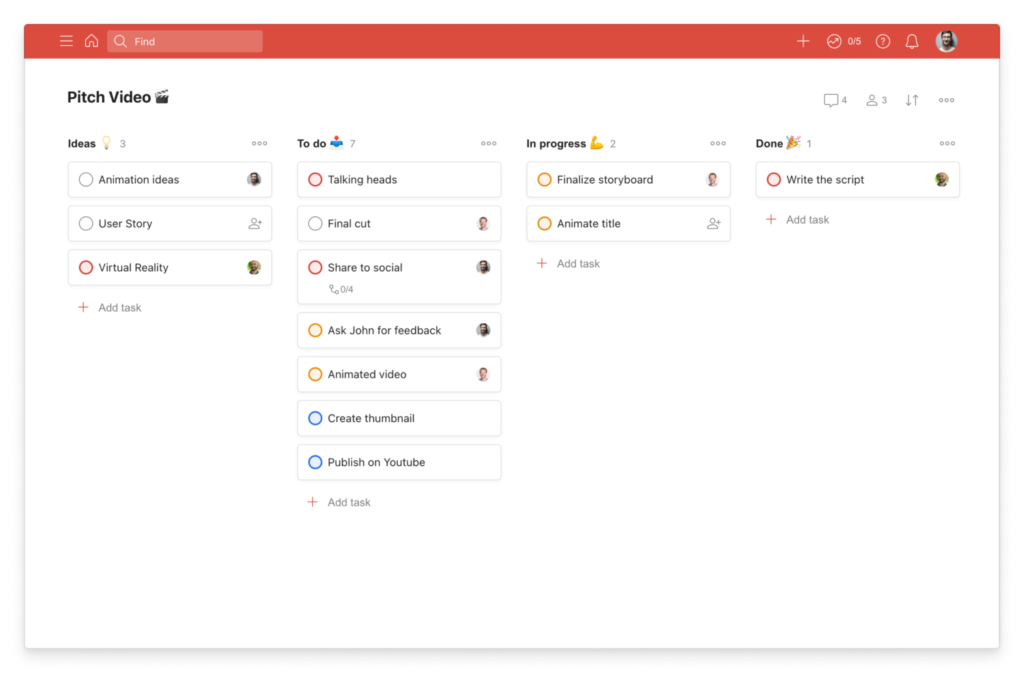
Task management apps have always existed, with many of them being perfect for many use cases, however, none have done it as well as ToDoist.
ToDoist is frequently said to be the best Task Management app since it offers many features that you simply can’t find in any other app while keeping a simple interface to not overwhelm the user.
You’re able to add tasks easily and sort them to your liking using Labels, Projects, and Priorities; using these features, you will be able to stay on top of your tasks, and know what to prioritize over others.
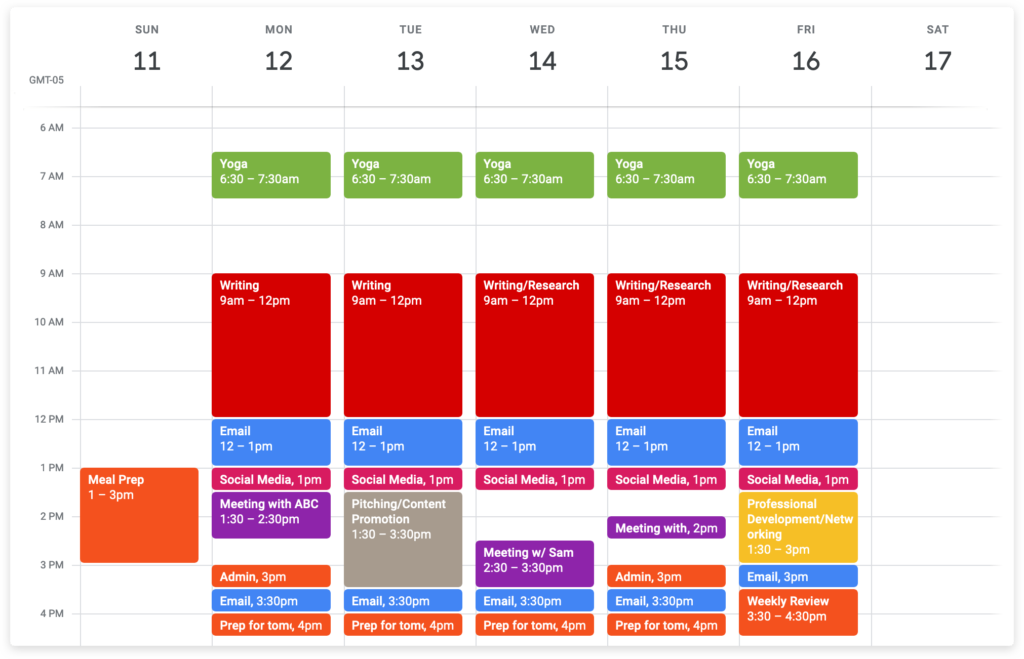
ToDoist also provides you with a Board view very similar to Sunsama’s where you can Timebox future tasks and drag and drop tasks into your timeline.
You can add tasks from Email, see your Calendar, Upload files, and visualize your productivity. ToDoist also has a mobile app so you can manage your tasks on the go.
Main Features
- Priority Levels
- Reminders
- Productivity visualizations
- Adding Tasks By Email
- Task Management For Teams
ToDoist offers a free plan where you can test out the app, but their paid plans start at $4/month if billed annually or $5/month if billed monthly, and $6/month/user if billed annually or $8/month/user if billed monthly for team plans.
3. Akiflow
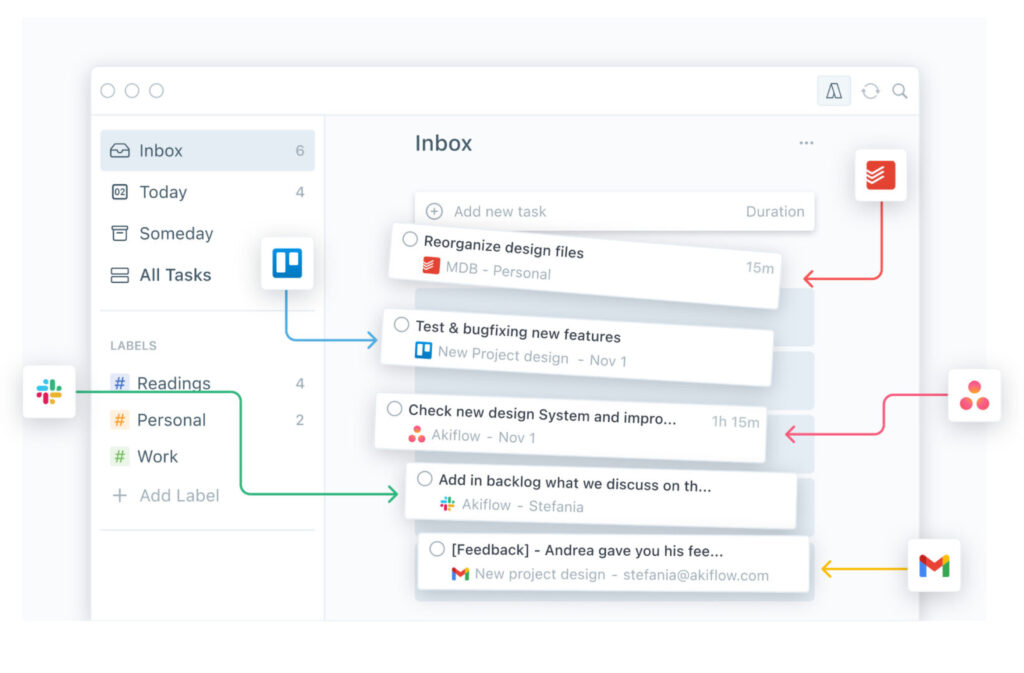
Akiflow offers a unique spell on task management apps since the app is one of the simplest Time Blocking apps I’ve ever used, but it is also one of the most functional.
upon opening the app, you’ll notice that there isn’t much to play around with, but you are able to import your tasks from other apps, email, and even use Zapier if your specific integration isn’t available with Akiflow.
Adding tasks to Akiflow is very easy; you can either add them from the app or click and drag over a specific timeframe in the calendar to add a task in that time and day.

Another way of adding tasks is by using the command bar, which is one of this app’s main features. You can add tasks using natural language, as well as signs to organize your task, for example, adding a “#” before the name of a Label you’ve made in the app will add the task to that Label, you can also add times, dates, description using “//” or scheduling a meeting with someone by tagging them.
You’ll also notice that keyboard shortcuts are very prevalent in Akiflow, so to get full use out of the app, you’ll have to adapt to some shortcuts.
Main Features
- Keyboard Shortcuts
- Labels
- Command Bar
- Simple UI
- Integrations
Overall Akiflow is a very good productivity app and Sunsama alternative, and you can try it for a week, or read our full review. Akiflow starts at $15/month but you’ll get 2 free months if you get the yearly plan instead.
4. Hourstack

Sunsama isn’t an app made for teams, even though you can add your team to sunsama to collaborate together, it is always more beneficial to use a dedicated team task management tool for your organization, and that’s why you should look at HourStack.
Hourstack is a Time Tracking, scheduling, and Task Management app for teams, but you can also use the app as a single user. Scheduling tasks is very easy using the drag-and-drop user interface to add tasks to your calendar. You’re able to view your calendar as well as your team’s calendar to better understand what everyone is doing.
You can also track your time from the HourStack calendar, as well as enter times manually for each of your tasks, you can also use the mobile app to track your time from there.
Hourstack isn’t only a task management app, it is also a work platform for your whole team, you can add tasks, clients, projects, roles, and more.
You can also use HourStack’s reporting feature to better understand how your team uses their time, and make sure it is used effectively as well as notice any inefficiencies in your team’s workflow.
Main Features
- Scheduling
- Time Tracking
- Workspace Platform
- Team Management
Hourstack has different plans for personal or team users. It costs $9/month if billed annually or $12/month if billed monthly for the personal plan. The Team plan costs $12/month/user for the annual plan or $15/month/user for the monthly plan.
5. Basecamp

Basecamp is also another great tool for managing your Tasks, and it also works well for teams. You can use it to create Projects and Tasks to assign to each member of your team.
You can also create subtasks, attach files, add deadlines to your tasks and have conversations about the task using the built-in message board.
the files you attach to your tasks can either be from Google Drive (or similar Cloud Services) or actually be hosted on Basecamp, which gives you some options.
You can also utilize a feature called status questions, which is made to replace status meetings and any unimportant meetings your organization holds.
If you’re working on a collaborative project with a client, you’re able to give the client access to your project so that they can see the timeline, tasks, and any attached files.
if you ever receive an important email that you want to discuss with the rest of your team, you’re able to forward that email to basecamp, so you can discuss it with your team.
Main Features
- Sorting by Projects
- Message Board
- Recurring Tasks
- Team Management
- File Hosting
If you manage a team, especially a remote one, then you need to try Basecamp and see if it fits your organization. Basecamp’s pricing differs from other apps since they only have 2 Plans. Basecamp has a limited free plan as well as a Business plan for $99/month flat for unlimited team members and unrestricted features.
6. TickTick
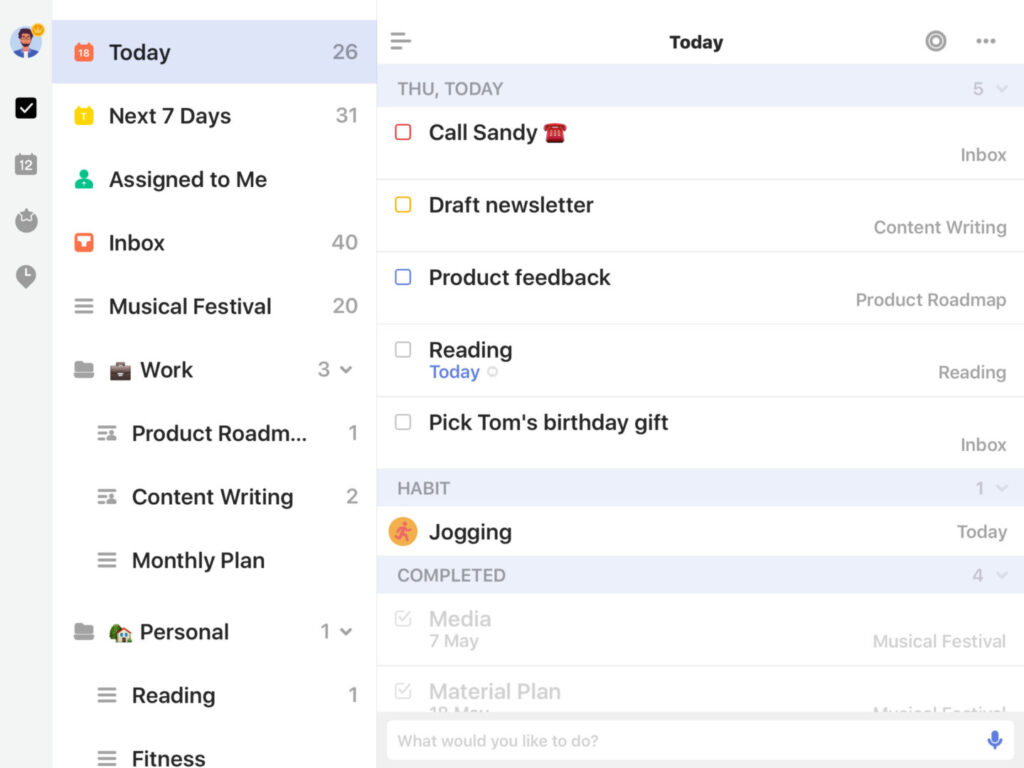
Another Veteran in the productivity game is TickTick. TickTick is aimed toward personal productivity, unlike other apps on this list which are more aimed toward remote teams and organizations.
TickTick It has all of the features you can expect from a great productivity app, as well as some extra features you find anywhere else.
TickTick has one of the best task segmentation out of all the apps on this list since you can sort by Task Priority, as well as assign labels to your tasks. You can also create folders to include your tasks.
You’re able to add tasks using your voice, add recurring tasks, create tasks from emails, add tasks from a voice assistant, as well as add tasks by typing using natural language, for example, if you want to add a task to remind you to pick up groceries at 3 pm, you can simply type “Get groceries 3 pm” and TickTick will automatically remind you when the time arrives.
If you have an important task you can’t miss, you can create multiple reminders for one task, or you can enable the “Annoying Alert” which will make sure you don’t miss your important task.
You can create task reminders based on your location, so whenever you arrive at a specific place, you will be reminded to do your task. This is only available on the iOS and Android mobile apps.
Speaking of apps, TickTick has many. You can get TickTick on your iOS or Android phone, Windows, macOS, Linux, iPad, Android Tablets, Apple Watch, and finally, it is available as a Web App. There is also a Chrome Extension, Firefox Extension, Outlook Add-in, and a Gmail Add-on.
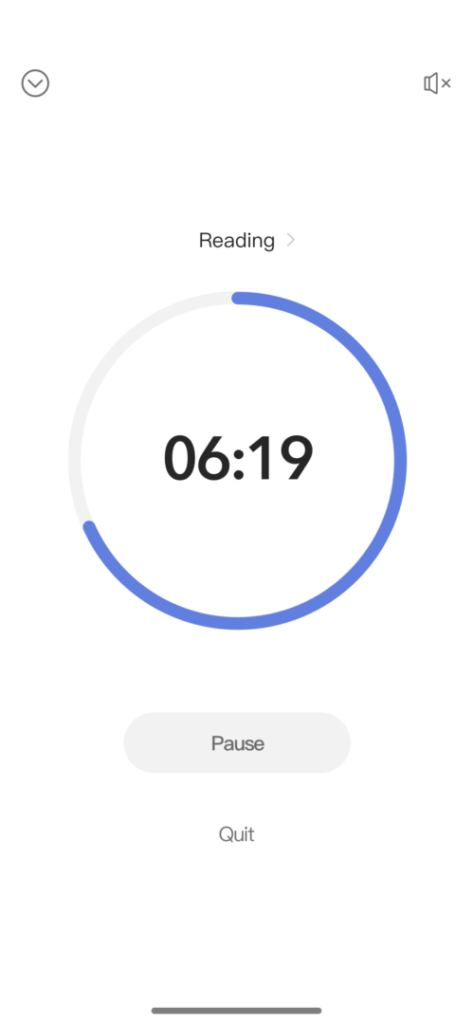
TickTick isn’t only used to manage tasks, you can also use it to help you do your tasks effectively since the TickTick mobile app does have some features you can use to increase your productivity, like the built-in Pomodoro Timer, or White Noise generator.
TickTick can also subscribe to external calendars you frequently use and you can see them in the calendar view in the app.
Main Features
- Available on 10+ Platforms
- Voice Input
- Calendar View
- Location-based Reminders
- Built-in Pomodoro Timer
- Folders, Labels, and Priorities
- Subscribing to 3rd-party Calendars
As you can see, TickTick is one value-packed Productivity app and is one of the best Sunsama Alternatives. and it also has a Free Plan where you can try most of its features before committing to their paid plan, which costs $27.99/year which is less than $2.5 per month!
7. List Zero
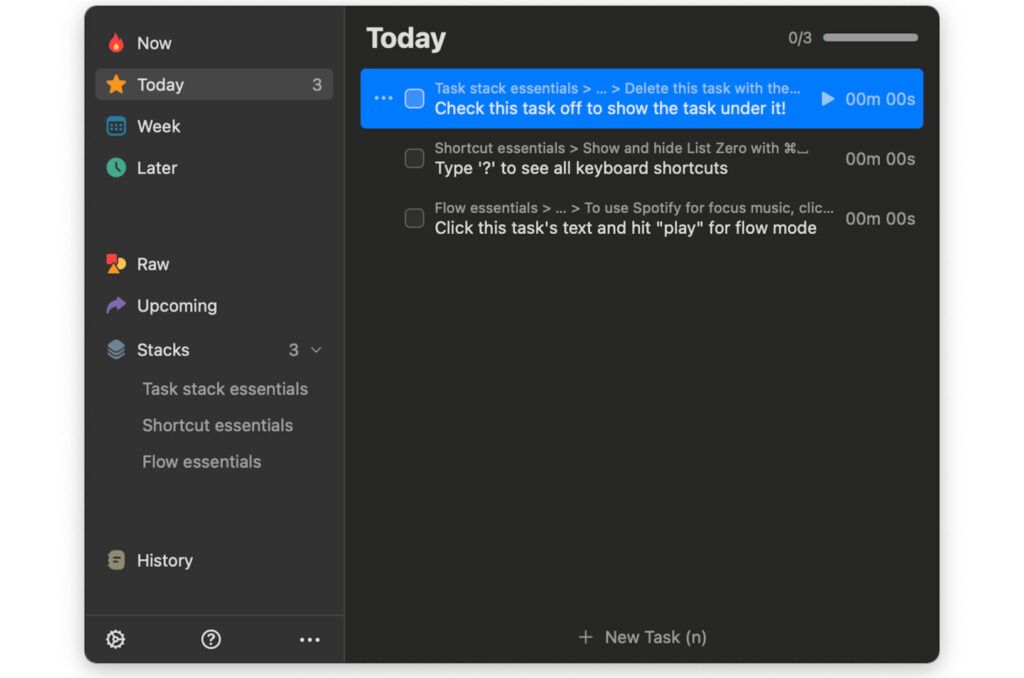
If you’re looking for a productivity app for mac, then List Zero should be one of your first choices. The app is very easy to use but has some powerful features.
The List Zero dashboard is very simple, and using it you can create Tasks, track your time with one click, as well as view your time summary to see how you spent your time.
Similar to Akiflow, List Zero relies heavily on keyboard shortcuts to provide the best experience, so you won’t find yourself having to let go of your keyboard to use your mouse.
You can also use a feature called “Flow Music” which will let you focus while working by playing calming music using Spotify in the background to help you get in the zone.
List Zero also does a little celebration after you complete a task, by shooting confetti all over your dashboard.
List Zero is meant to be an app that helps you achieve a Flow State of Work, so you can focus on the task at hand, without having to snap out of your productive mindset to find something to work on, or track your time.
Main Features
- Simple Dashboard
- Keyboard shortcuts
- Flow Music
- One-Click Time Tracking
All in all. List Zero is a pretty simple app, and if you are hesitant to try it, you can test it out with the 14-day trial before committing to their $4/month plan.
8. Trello
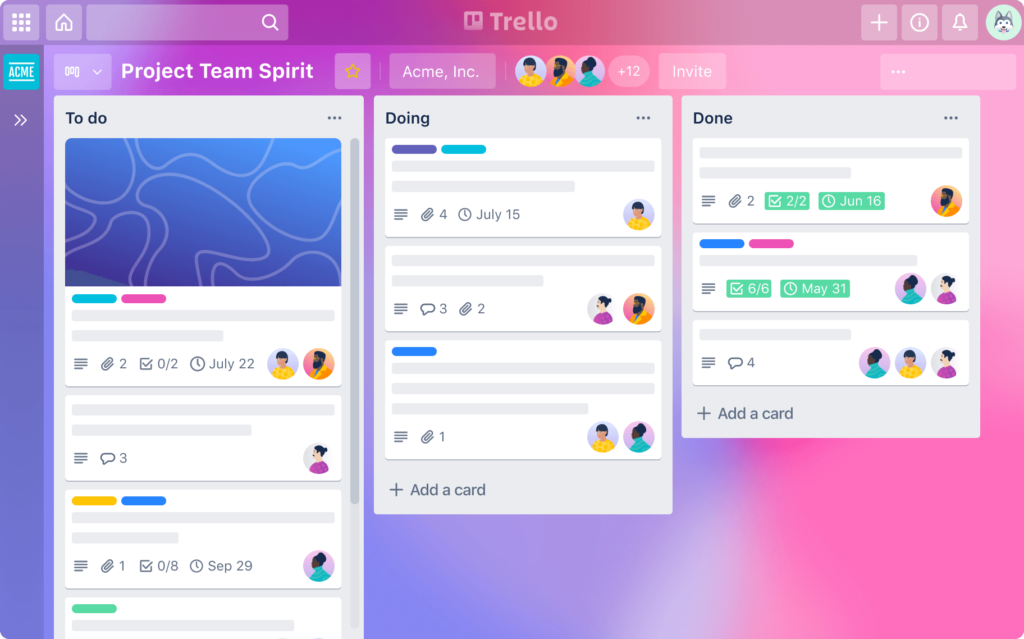
Trello is one of the leading Kanban-style Task management apps for teams, and it is used by many organizations around the world like Coinbase, Google, Zoom, and Visa.
Trello’s main view the called the “Trello Board” which is just a Kanban board, but with the Trello sparkle on top. Each Trello Board can have multiple “Lists “which are similar to steps in your workflow, for example, you can have lists for “To-Do”, “Doing”, and “Done”, and you can sort tasks into them depending on the stage the task is in.
You can also view your tasks in the timeline view, the calendar view, and the Map View, which is especially nice if you have a team that often has to travel between locations for work. There is also the Table View, which is very similar to a spreadsheet where you can see your tasks, who’s assigned to them, due dates, and more.
you can also see if your team is being productive using the Dashboard View, where you can view insights on what your team is doing, the progress done in each task, and more data about your organization.
Another great part of Trello is Butler, which is the automation engine built into the app, that you can use to automate practically anything in Trello, from changing the status of tasks, assigning team members, adding a due date, marking tasks as complete, as well as integrating with all of your favorite apps, like Slack and Jira. Butler will also recognize repetitive actions you do and suggest you automate those as well.
however, there are always going to be missing features you need, which is why Trello has “Power-Ups” that you can install on your Trello Board to add missing features, like a Voting feature, List Limits, Google Calendar 2-way sync, and more! You can also create Power-Ups and share them or create private power-ups for your organization.
There is also a pretty big template library that you can utilize so you don’t start from square one when you switch to Trello. Templates range from ones for Marketing Teams, Design Teams, Education, and Engineering, to ones for Remote Work, and Podcasting.
Main Features
- Power-Ups
- Multiple Views
- Power Automation Engine
- KanBan Board
Trello is a very robust app made to actually make you more productive, instead of spending time checking in with all of your team members, you can do so in the comfort of your own dashboard. Trello has a limited free plan, and its paid plans start at $5/month/user if billed Annually.
9. Routine
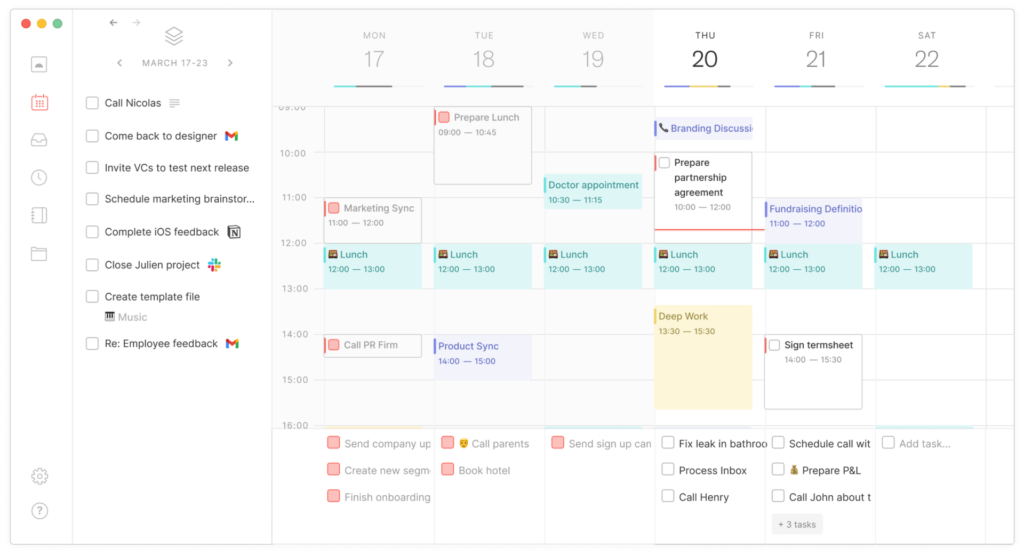
Routine is a bit of a newcomer in the productivity space, but that doesn’t mean that their app is lacking in the features department. The app wants to help you take back control of your time.
Routine’s “Superhuman Calendar” is one of if not the best calendars available in all productivity apps I’ve ever tested. it can bring together all of your calendars, and any changes done to the routine calendar will automatically reflect on all of your other calendars in your account.
Routine’s Universal Inbox acts like a “catch-all” for unsorted and unlabeled tasks that you add, tasks added by apps will also be found there until you find time to sort them.
Routine also has a smart scheduling feature, which automatically schedules tasks around your already scheduled tasks, and it makes sure you can get to finishing all of your tasks on time.
You can connect all of your favorite project management tools that you use to routine, so you can import all of your tasks from those tools as well. You can also convert emails as well as chats, into tasks. You can add chats from Whatsapp, Slack, and Telegram.
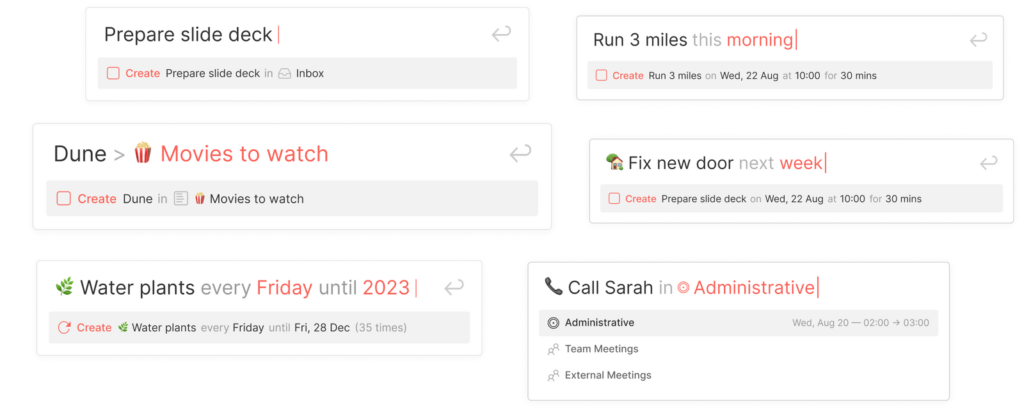
Routine also has a command bar similar to other apps on this list, but it arguably is the best, since you use it to add events, tasks, notes, and recurring tasks with an optional start and end date. The Command Bar also understands natural language, so you add dates and times to the command, and the app will automatically understand, you can also tag people, and the app will automatically book the meeting.
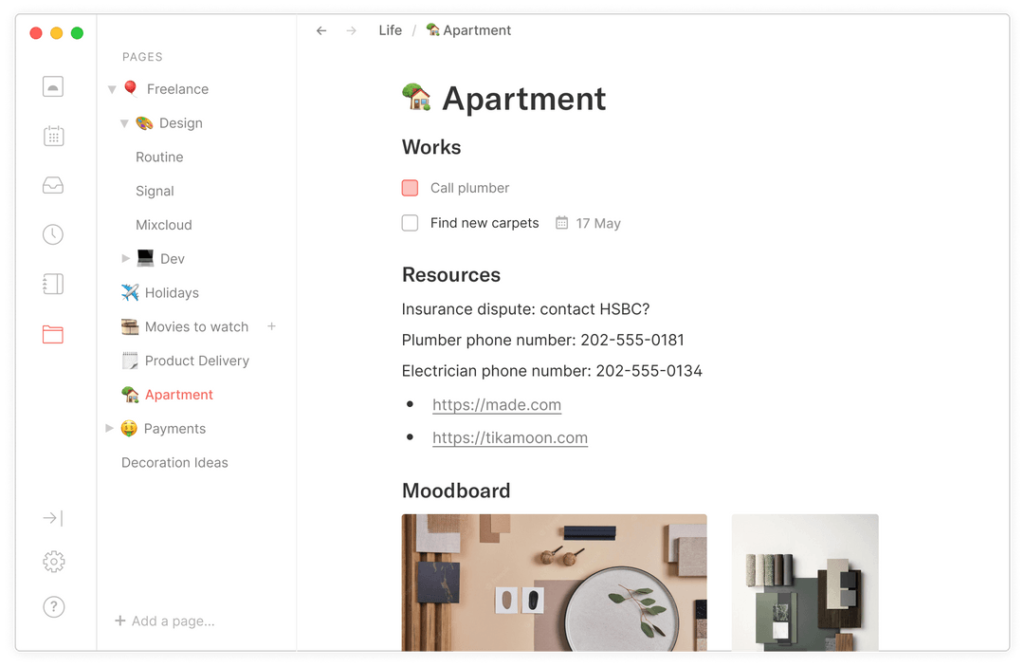
Routine also has a system where you can create pages and notes within the app, similar to a personal wiki built right into the app! Routine is one of the first apps to include a feature like this.
Main Features
- Smart Scheduler
- Pages
- Universal Inbox
- Superhuman Calendar
- Command Bar
Routine is one of the most feature-packed productivity apps to ever hit the market, and its features will only increase from here. I’m excited to see where it goes. Routine is still in early access, and it doesn’t have a public release yet, but you can always join the queue and request access.
10. Reclaim.ai

Reclaim is very Similar to Motion, which is the first app found on this list; They are especially similar in the AI department since they both use AI to sort out your calendar and to make sure you can get to doing everything in your task list.
Reclaim’s main view is the calendar view, which will pull any time booked by you in other Google Calendars you add to Reclaim, to show you everything you need to see on one dashboard.
Reclaim also has a Task Manager Built-in so you can use it to manage your tasks as well as plan when you will do the actual task, you can also pull tasks from other Task Management apps, so you manage them all in Reclaim.
When adding a task to Reclaim, you can add some data to your task, to better help Reclaim pick the best time to block time for your task. Tasks in Reclaim can include how much time you need to complete the task, subtasks, type (Personal, Work, etc) its priority, as well as the privacy of the task, since Reclaim can hide your task’s details on your Google Calendar by just titling the task as “Busy”.
If your organization uses Slack, then you’re in luck, since Reclaim has a feature where you can add tasks straight from the Slack App.
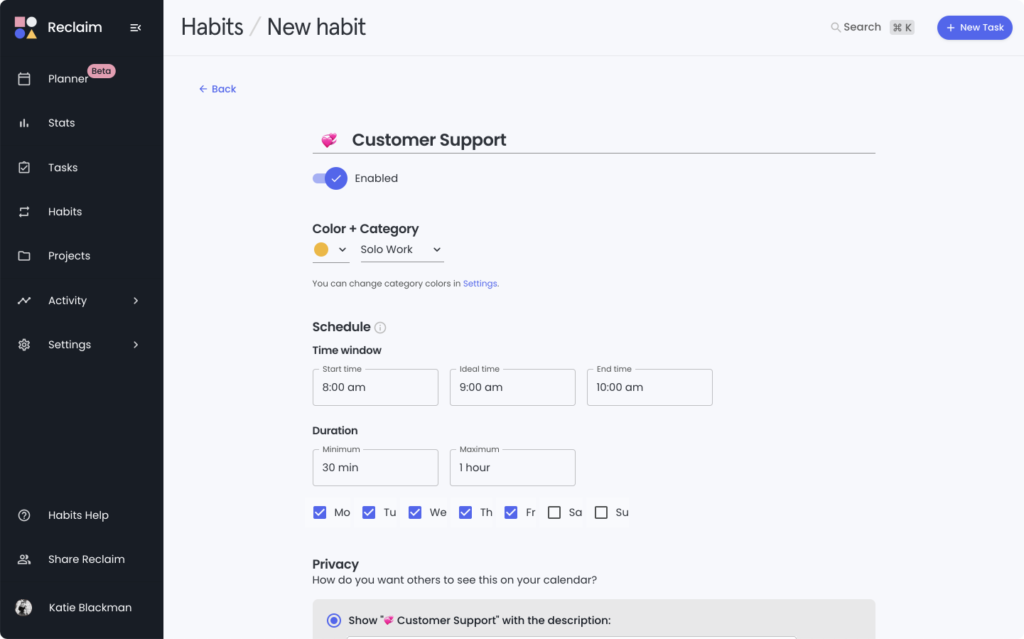
Another great feature of Reclaim is the ability to add “Habits” that are similar to recurring tasks; you can tell Reclaim how often you want to get them done, the timeframe you want to complete the task in, the duration of the task, and everything else you can add to a normal task.
Reclaim will also show you your stats of how productive you’ve been this week, as well as send them to you in an email, but you can opt out of receiving them.
If you hate back-to-back meetings, then you should check out Reclaim’s “Buffer Time” Feature. When enabling Buffer Time, reclaim will automatically add a 15-minute period after meetings, where other meetings cant be booked, and you can change the duration of the buffer time as well.
Planning a meeting shouldn’t be a complicated process, but sadly, it is. Planning a meeting will consist of sending over your available times, waiting for the other attendee of the meeting to see if they would be free at that time (which most of the time they are not), and finally, clearing your schedule so you can attend the meeting. Reclaims “Smart 1-on-1s” aim to solve exactly that, by checking each user’s calendar and seeing what the best time would be for both users. You can also convert normal 1-on-1 meetings into Smart 1-on-1s.
Main Features
- Buffer Time
- Smart 1-on-1s
- Planner
- Habits
- Calendar
Reclaim is one of the best AI apps that are out on the market, and I’d suggest Testing Motion as well, to see what would work better for you. Reclaim has a free plan, as well as plans starting at $6.50/month if billed annually, and $7.80/month if billed monthly. Reclaims team plan starts at $9.50/month/user if billed annually, and $11.40/month/user if billed month to month.
11. nTask
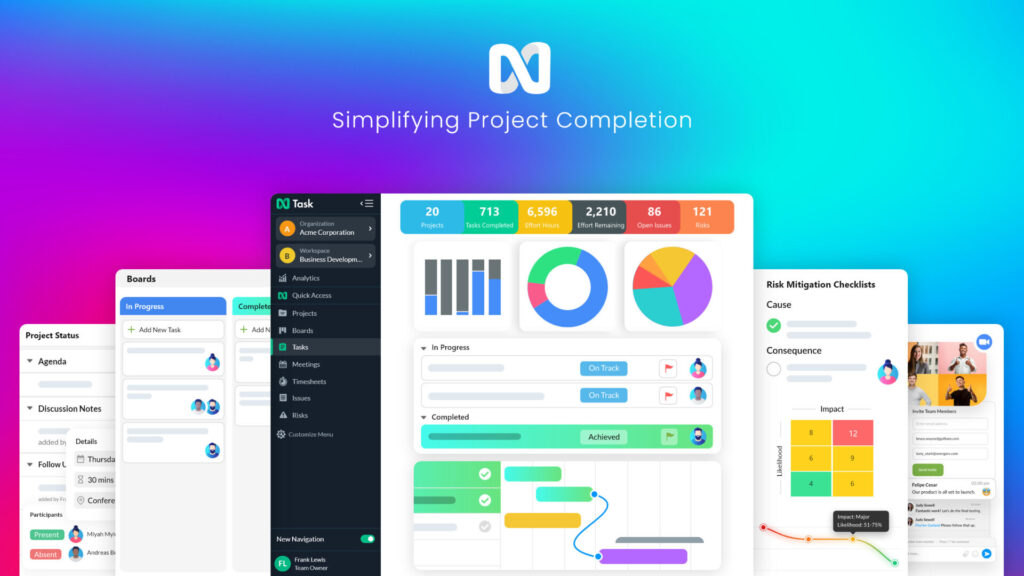
If you’re looking for a Project Management software, not a Task Management app, then you should try nTask. nTask is one of the leading PM software available.
nTask has many features that will make your Project Planning a breeze, like Budgeting per project, resource allocation, customizing a billing method, choosing the payment terms, and more.
nTask’s Kanban view is very similar to Sunsama’s but is more customizable since you can change the background color, add custom fields, and customize the board’s statuses.
nTask’s Team Chat provides your team with a Synchronized Communication Platform so you can collaborate with your team, share updates with your whole organization, and share files with your team.
nTask isn’t only a Project Management app, it is also a Task Management app as well. You can use it to instantly plan tasks, and assign them to your team. Each task can have unlimited subtasks, attachments, planned and actual dates, as well as be repeatable.
You can also view your projects in a Gantt Chart to see their progress. nTask also has meeting management capabilities that you can use to plan meetings, invite team members, as well as use the built-in meeting agenda, you can also integrate your meeting software of choice with the app, so you can easily schedule the meeting there as well.
nTask also has Issue Tracking and Risk Management features, where you can manage and prioritize issues based on their severity as well as link them to their respective tasks.
Main Features
- Risk Assesment
- Issue Tracker
- Project Budgeting
- Multiple Views
nTask is one of the only Project Management tools on this list, and in my opinion, it is one of the best Project Management apps on the market. nTask has two paid plans as well as an enterprise plan. Plans start from $3/month/user if billed annually.
12. TimeCamp
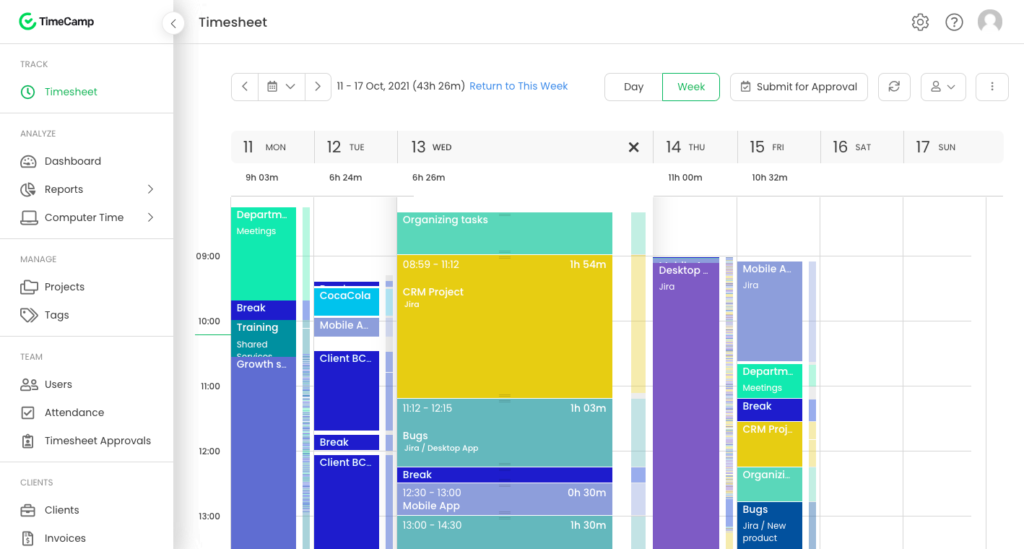
If you and your team are working on billable client projects or projects which require tracking your time, then TImeCamp should be one of the first options you try.
TimeCamp is an app very focused on time tracking, billing clients, and managing your team, that’s why you will see many features focused on being productive like tracking your team’s performance, seeing what apps they spend time on, as well as the ratio of work-related apps and websites to non-work related apps.
TimeCamp also has a view where you can see the budget of your project to make sure you won’t go over budget; you can also view your profit margin across different projects. so Budgeting will be very simple.
TimeCamp will also sort all of the apps you frequently use into pre-defined categories, it will also automatically categorize domains you spend your time on, so you can find out what categories you spent your time on.
Using TimeCamps billing feature, you and your team can distinguish and mark time as billable or non-billable to make invoicing your clients simpler.
and finally, TimeCamp also has an invoicing application, attendance reporting, and timecard approvals with one click.
Main Features
- Timecard Software
- Invoicing Software
- Billing System
- Billable and Non-Billable distinguishing
TimeCamp is a great app if you run a marketing agency or another type of organization that works with multiple clients and needs a better system to track their hours. TimeCamp has a free plan, and their paid plans start at 6.3/user/month if billed yearly, and or $7/month/user if billed monthly.
Conclusion
There’s no denying that Sunsama is one of the best productivity apps, but as we all know, productivity apps aren’t one-size-fits-all, so Sunsama might not suit your productivity style, which is why it is good to try multiple apps from this list to see which one will suit you.


